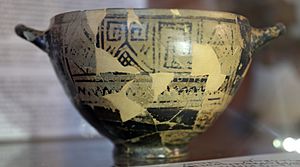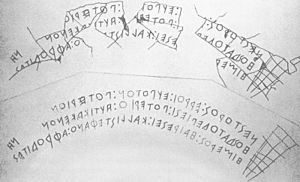Nestor's Cup (Pithekoussai) facts for kids
The Nestor's Cup is a very old wine cup from around 750 BC. It was found in 1954 on an island called Ischia in Italy. This island was once home to an ancient trading town called Pithekoussai.
The cup has a special three-line message written on it. This message is one of the oldest examples of writing we have in the Greek alphabet.
Contents
What is Nestor's Cup?
The cup is a type of ancient drinking vessel called a skyphos or kotyle. It was made in Rhodes in the 700s BC. The cup has a cool design called the Geometric style.
It was discovered in 1954 inside a grave on the island of Ischia. The grave was for someone who had been cremated, meaning their body was burned. This grave dates back to just before 700 BC.
Who was buried with the cup?
Scientists first thought the grave belonged to a child, maybe 10 to 14 years old. But newer studies show that the remains are actually from three different adults. There were also some animal bones found, which means animals might have been part of the cremation ceremony.
Besides the cup, the grave also held pieces of 25 other vases. A silver brooch was found there too. The body was burned on a separate fire, and the items found in the grave were also ritually broken and burned on the same fire.
The Special Message
A three-line message is scratched onto the side of the cup. This message is one of the very first examples of Greek writing that we still have today. The message was added to the cup after it was made, probably in the late 700s BC.
What does the message say?
The writing is in a style from a place called Euboea. The letters are small and neat. What's really interesting is that all three lines are written from right to left. This is quite rare for ancient Greek texts. A special symbol ":" is used to separate words.
The message is a short poem. It says:
|
Νεστορος : ε[ιμ?]ι : ευποτ[ον] : ποτεριον : |
I am the cup of Nestor, good for drinking. |
The second and third lines of the poem follow a specific rhythm, like in epic poems. The first line's rhythm is a bit less clear to experts.
What does it mean?
There's a small missing part in the first line of the message. Because of this, experts have different ideas about what the cup is trying to say.
- Some think the cup is saying it's not the famous cup of Nestor from the ancient Greek story, the Iliad. Instead, it's just a regular cup that's good for drinking.
- Others believe the cup is actually claiming to be Nestor's cup.
Over the years, many different ways to fill in the missing part have been suggested. Today, many experts think the cup is indeed claiming to be Nestor's. However, some newer ideas still suggest it's comparing itself to Nestor's famous cup, rather than being it.




